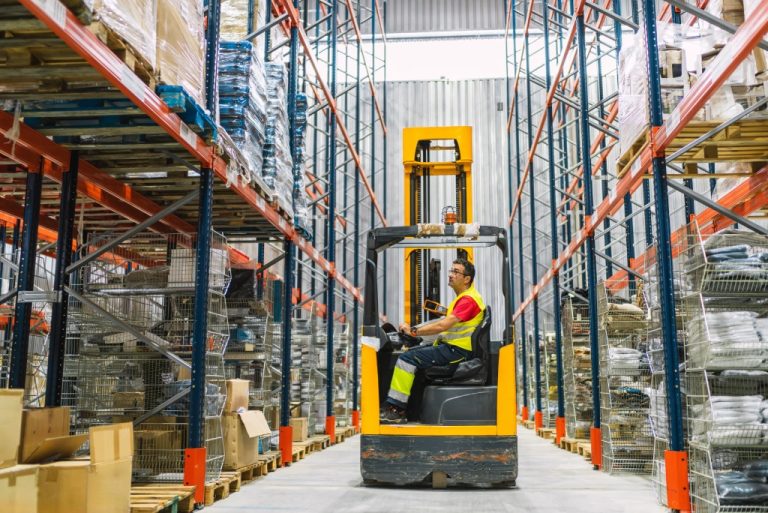The significance of efficient warehouse layout design goes beyond just using space well. It directly influences KPIs like order fulfillment rates, picking efficiency, inventory accuracy, and labor productivity. A well-planned warehouse design and layout can significantly reduce operational costs, improve worker safety, and enhance customer service.
On the flip side, the story goes downhill fast, and that impacts your bottom line. Inefficiency in warehouse operations, inventory management, and material handling accounts for losses of around $1.1 trillion every year.
Increasing customer demands, holding costs, labor costs, and expenses require increasing efficiency. Research from McKinsey shows that you can reduce costs by 20% to 50% by employing lean principles in warehouse storage layout design. Yet, many warehouse operators have yet to reconfigure their facilities to achieve such gains.
In this guide, we’ll discuss ways to increase your warehouse capacity, organize your warehouse for peak efficiency, and overcome the key barriers to reducing operational costs. First, let’s discuss the fundamentals of warehouse layout design.
The Fundamentals: Warehouse Design Principles
These principles form the foundation upon which your design should be anchored. They provide an efficient workflow for safe operations.
- Flow: Ensure a logical and efficient movement of goods from receiving to shipping.
- Accessibility: Make sure all areas and items are easily reachable when needed.
- Flexibility: Design with future growth and changing needs in mind.
- Space utilization: Maximize the use of both horizontal and vertical space.
- Safety: Prioritize the well-being of workers and the security of goods.
How to Fully Utilize Warehouse Capacity
Your warehouse design and layout should optimize your capacity regardless of space constraints. Here are a few examples of how the right floor plan can increase your capacity.
Vertical Space Optimization
One of the most overlooked opportunities in warehouse design is the effective use of vertical space. Many warehouses have untapped potential literally hanging overhead.
Implementing high bay racking systems is an excellent way to take advantage of ceiling height, allowing for the storage of more items in the same floor space. These systems can often double or triple the storage capacity of a traditional racking setup.
In addition to high bay racking, installing mezzanine floors can create additional usable space above ground level. These elevated platforms effectively add a second or third floor to your warehouse, perfect for storing smaller items, creating office space, or setting up processing areas.
By thinking vertically, you can dramatically increase your usable square footage without expanding the building’s footprint.
Aisle Width Optimization
The space between storage units is just as important as the warehouse storage layout design itself.
Optimizing aisle width can lead to significant gains in storage density.
Narrow aisle racking systems allow for closer placement of shelving units, increasing the number of aisles and, consequently, the amount of storage space in the same area. This approach requires specialized equipment, such as reach trucks or articulated forklifts, but the gains in storage capacity often justify the investment.
For maximum space utilization, consider implementing very narrow aisle (VNA) systems. These systems reduce aisle widths to an absolute minimum and often include guided vehicles that move on rails for precise movement in tight spaces. VNA systems can increase storage capacity by up to 50% over conventional layouts.
Implementing Cross-Docking
Cross-docking is a logistics practice that can significantly reduce storage needs for fast-moving items. By setting up dedicated areas for cross-docking, warehouses can transfer incoming shipments directly to outgoing vehicles with minimal or no storage time. This approach not only saves space but also reduces handling costs and improves delivery times.
Utilizing Dead Space
Even in the most efficiently designed warehouses, there are often underutilized areas that can be repurposed for storage. These “dead spaces” might include corners, areas above dock doors, or spaces beneath stairways. By identifying and creatively using these areas, warehouses can squeeze extra storage capacity from their existing layout.
These often-overlooked spaces can be perfect for storing slow-moving items or seasonal inventory. For instance, the area above dock doors can be fitted with cantilever racks for storing long, lightweight items like pipes or lumber. Corner spaces, which are sometimes difficult to access with standard equipment, can be outfitted with carousel systems for storing small parts or tools.
By thinking creatively about every square foot of the warehouse, you can uncover hidden storage potential and maximize their space utilization.
What Is the Best Way to Organize Your Warehouse?
There are different types of warehouse designs and layouts. Which one is right for you will depend on your space, workflow, and inventory. The most common types of layouts are:
- U-shaped: Forms a “U” shape with receiving and shipping on the same side, optimizing material flow and reducing travel time.
- L-shaped: Receiving and shipping are on adjacent sides, reducing congestion and allowing for flexible space utilization.
- I-shaped: Goods flow in a straight line from receiving to shipping, ideal for high throughput and clear separation of processes.
- Modular: Divides the warehouse into distinct sections (modules), offering flexibility and easy scalability.
- Cross-docking: Minimizes or eliminates storage by directly moving goods from receiving to shipping, perfect for just-in-time operations.
- Multi-story: Utilizes vertical space with multiple storage levels, maximizing space in areas with high land costs.
- Cellular: Divides the warehouse into cells based on product categories or functions, increasing efficiency by grouping similar goods.
- Flow-through: Emphasizes continuous movement of goods from receiving to shipping with minimal handling and temporary storage.
When you think about how to make warehouse material handling more efficient, consider the layout and your workflow.
What Are Some Ideas for Designing a Warehouse Layout?
Our best advice is to get expert guidance from pros when considering warehouse design and layout. Experienced warehouse design professionals will have the expertise to create optimal layouts. They’ll also have design tools and skilled engineers to produce the visualizations and engineering documents you’ll need for permitting.
One recent study of material handlers uncovered that 89% are still using PowerPoint software or creating PDFs when envisioning warehouse spaces. This simply doesn’t cut it. You need CAD drawings to provide a real-world visualization of your warehouse environment. Conesco Storage Systems can help. Team members have more than 250 years of combined warehouse planning experience and deep experience adapting best practices to customized warehouse layout designs.
Some other ideas for designing an efficient warehouse layout include:
- Flexible design for scalability: Create modular spaces that can be easily reconfigured and leave room for expansion in high-growth areas.
- Incorporating staging areas: Designate specific areas for order staging near shipping docks and create buffer zones to manage peak period volumes effectively.
- Designing for reverse logistics: Allocate space for returns processing and quarantine areas, implementing a streamlined flow for returned items to re-enter inventory or be disposed of.
- Implementing value-added service areas: Designate spaces for activities like kitting, labeling, or light assembly, ensuring these areas are integrated seamlessly into the warehouse flow.
- Considering environmental factors: Design for optimal natural and artificial lighting to improve visibility and reduce energy costs, while implementing proper ventilation systems to maintain air quality and temperature control.
Warehouse Automation Systems
Integrating automation for enhanced efficiency, such as conveyors, automated storage and retrieval systems (AS/RS), or robotics can also help optimize space utilization and streamline operations.
When planning your warehouse design and layout, consider how automated systems can help maximize space utilization and improve workflow. For example, vertical carousel systems or AS/RS can make better use of vertical space. Conveyor systems can be designed to efficiently move goods between different areas of the warehouse, reducing manual handling and improving throughput. By incorporating automation into your layout design, you can create a more dynamic and responsive warehouse environment.
Automation can provide a competitive advantage and reduce your labor costs, but waiting to incorporate automation into your warehouse storage layout design puts you at a disadvantage. A study by Parcel Industry reported that 60% of companies plan to invest in conveyor systems, sortation systems, and more warehouse automation over the next three years.
What Are the Major Barriers to Warehouse Productivity?
Designing an efficient warehouse layout requires understanding the barriers that prevent you from optimization. Some of the major obstacles include:
- Poor space utilization: Inefficient use of vertical space and poorly designed storage systems lead to wasted space.
- Inefficient picking processes: Long travel distances for pickers and poorly organized inventory cost you time wasted searching for items.
- Inadequate inventory visibility: Lack of real-time inventory information and difficulty in locating specific items quickly.
- Lack of proper staff training: Insufficient knowledge of warehouse layout and processes, and inadequate skills in using warehouse technology and equipment.
- Outdated technology and equipment: Use of manual processes where automation could improve efficiency, and old or poorly maintained material handling equipment.
Addressing these barriers with expert warehouse design and layout can significantly boost productivity and operational efficiency.
Frequently Asked Questions — FAQs
Why is an efficient warehouse design and layout important?
An efficient warehouse design and layout is crucial for optimizing operational performance. Benefits include:
- Increased operational efficiency
- Reduced labor costs
- Enhanced inventory accuracy
- Improve storage capacity
- Better worker safety
An efficient and safe warehouse can improve employee satisfaction, key to reducing turnover and retaining key workers. That’s critical in the warehouse industry, which forecasts a shortage of more than two million workers by 2030 according to the National Association of Manufacturers.
Implementing ergonomic design, reducing travel time, and mitigating risk create a healthier environment for employees in an industry that too often suffers from workplace mishaps.
How can I control inventory in a warehouse?
Effective inventory control in a warehouse requires a multifaceted approach combining technology, processes, and human expertise. Implementing a robust warehouse management system (WMS) is crucial for real-time tracking and reducing manual errors. A G2 report found that 62% of those surveyed cited human error from manual processes as the top cause of inventory fulfillment issues, underscoring the importance of automation.
How can you ensure accurate inventory levels in a warehouse?
Ensuring accurate inventory levels in a warehouse involves a combination of strategic practices and smart design. Regular cycle counts and annual physical inventories are crucial for verifying stock levels, while implementing barcode or RFID technology enables real-time tracking and reduces human error.
The warehouse layout also plays a significant role in inventory accuracy by supporting easy counting and access to inventory, reducing the chance of misplaced items, and enabling efficient stock rotation. An optimal warehouse storage layout design also reduces pick and putaway errors to aid in accurate inventory counts.
Get Effective and Efficient Warehouse Storage Layout Design
Don’t risk DIY solutions for warehouse planning and design. You can trust the experts at Conesco Storage Systems to create optimal, customized layout plans and guide you through the entire process. From efficient designs and engineer-stamped documents, permitting, and specialized labor for installation, Conesco Storage Systems can create the warehouse layout design you need to optimize your warehouse workflow. Whether you’re building a new warehouse from the ground up or looking to optimize an existing facility, our team can help you design an efficient layout to power your warehouse and your profitability.
Contact the warehouse planning experts at Conesco Storage Systems today. Request a consultation or call one of our experienced team members at (303) 690-9591. A nationwide leader in turnkey warehouse and material handling solutions, Conesco Storage System can handle all of your warehouse equipment and layout needs.



